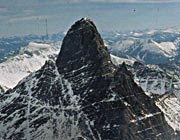



After we leave Banff on Day 10, we head south, back to the US, to Glacier National Park. I have a whole day planned for the drive. On Day 11, we take the Going to The Sun Road. Here's what the NPS says about this road.
The construction of the Going-to-the-Sun Road was a huge undertaking. Even today, visitors to the park marvel at how such a road could have been built. The final section of the Going-to-the-Sun Road, over Logan Pass, was completed in 1932 after 11 years of work. The road is considered an engineering feat and is a National Historic Landmark. It is one of the most scenic roads in North America. The construction of the road forever changed the way visitors would experience Glacier National Park. Future visitors would drive over sections of the park that previously had taken days of horseback riding to see.
Just across the border, in Canada, is Waterton Lakes National Park. In 1931, members of the Rotary Clubs of Alberta and Montana suggested joining the two parks as a symbol of the peace and friendship between our two countries. In 1932, the United States and Canadian governments voted to designate the parks as Waterton-Glacier International Peace Park, the world's first. More recently the parks have received two other international honors. The parks are both Biosphere Reserves, and were named as a World Heritage Site in 1995. This international recognition highlights the importance of this area, not just to the United States and Canada, but to the entire world.
While much has changed since the first visitors came to Glacier, it is possible to relive some of Glacier’s early history. You can take a horseback ride like an early visitor. Miles of hiking trails follow routes first used by trappers in the early 1800's. Several hotels and chalets, built by the Great Northern Railway in the early 1900's, house summer guests to the park. A visit to Glacier National Park is still a great adventure!
I can't wait to see it...!!!




No comments:
Post a Comment